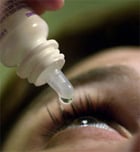Key points
- Pink eye is a treatable eye condition.
- Sometimes you can manage pink eye at home without medical treatment.
- It's important to seek medical care for some types of pink eye or if you have complications.

Treatment overview
There are times when it is important to seek medical care for pink eye. However, this is not always necessary.
Managing symptoms at home
Use cold compresses and artificial tears to help relieve some of the inflammation and dryness caused by pink eye. You can purchase these over the counter without a prescription.
Stop wearing contact lenses until your eye doctor says it's okay to start wearing them again. If you did not see a doctor, do not wear your contacts until you no longer have pink eye symptoms.
When to see a healthcare provider
If your newborn has pink eye
See a healthcare provider if you have pink eye along with any of the following:
- Eye pain
- Light sensitivity
- Blurred vision that does not improve when discharge is wiped from the eyes
- Intense eye redness
- Symptoms that get worse or do not improve
- If you have bacterial pink eye which does not improve after 24 hours of antibiotic use
- A weakened immune system (body's ability to fight germs and sickness)
Healthcare providers can usually identify pink eye by examining the eye while considering patient history and other symptoms. Sometimes, they might collect a sample from the patient's eye and send them to a laboratory type of pink eye.
For specific types of pink eye
Viral pink eye
Most cases of viral pink eye are mild. It usually clears up in 7 to 14 days without treatment and without any long-term consequences. However, in some cases, viral conjunctivitis can take 2 to 3 weeks or more to clear up.
A doctor can prescribe antiviral medication to treat more serious forms of pink eye (like infection caused by herpes simplex virus or varicella-zoster virus).
Antibiotics will NOT improve viral pink eye; these drugs are not effective against viruses.
Bacterial pink eye
Mild bacterial pink eye may get better without antibiotic treatment and without causing any complications. It usually clears up in 2 to 5 days without treatment but can take 2 weeks to go away completely.
Your doctor may prescribe an antibiotic, usually given topically as eye drops or ointment, for bacterial pink eye. Antibiotics may help shorten the length of infection, reduce complications, and prevent the spread to others. Antibiotics may be necessary in the following cases:
- With discharge (pus)
- If you have a weakened immune system
- When certain bacteria are suspected
Talk with your doctor about the best treatment options for your infection.
Allergic pink eye
Remove allergen. Pink eye caused by an allergen (such as pollen or animal dander) usually improves by removing the allergen from the person's environment.
Allergy medications and certain eye drops (topical antihistamine and vasoconstrictors), including some prescription eye drops, can also provide relief from allergic conjunctivitis. In some cases, your doctor may recommend a combination of drugs to improve symptoms. Your doctor can help if you have pink eye caused by an allergy.
